|
|
|
Sort Order |
|
|
|
Items / Page
|
|
|
|
|
|
|
| Srl | Item |
| 1 |
ID:
091552


|
|
|
|
|
| Publication |
2009.
|
| Summary/Abstract |
In the context of emission markets, failure to include early action (EA) as a criterion when sharing out the reduction effort may be unfair. This paper presents (1) a method based on index decomposition that seeks to quantify EA and (2) a method for determining effort sharing considering EA. It is shown that, in the case of European industry (EU-15) and for the period 1995-2005, EA accounted for a reduction of 21% in energy-related CO2 emissions. Considering two alternative schemes for sharing out the reduction effort in European industry, equal shares (all industries in all countries reduce their emissions by the same percentage) and taking EA into account, we find that Spain, Austria, Italy, the United Kingdom and Sweden would be better off under an equal shares scheme as opposed to one that takes EA into account. The efforts of the remaining countries would be greater than if EA was taken into account. An equal shares scheme would also greatly benefit the textile, non-metallic mineral, paper and "other" industries, and would be particularly detrimental to the chemical, non-ferrous and other metal, and engineering industries.
|
|
|
|
|
|
|
|
|
|
|
|
|
|
|
|
| 2 |
ID:
091564
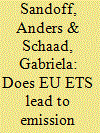

|
|
|
|
|
| Publication |
2009.
|
| Summary/Abstract |
The first trading period of the European Emissions Trading Scheme (EU ETS) has recently come to an end. The experiences of the actors in the trading sector will be of great importance in evaluating the aim and direction of this "Grand Policy Experiment". This paper gives an account of the attitudes and actions of the companies included in the Swedish emissions trading sector after about 15 months of experience with the system. The data are based on a study commissioned by the Swedish Environmental Protection Agency, and is a comprehensive survey that encompasses all companies operating installations included in the Swedish Emission Trading Registry. However, the results point in a somewhat disquieting direction. Although the Swedish companies have shown significant interest in reducing emissions, this survey indicates that this is done without close attention to the pricing mechanism of the market-based instruments. If this praxis is widespread within the European trading sector, it can have a serious negative effect on the efficiency of the system.
|
|
|
|
|
|
|
|
|
|
|
|
|
|
|
|
| 3 |
ID:
098273
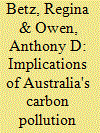

|
|
|
|
|
| Publication |
2010.
|
| Summary/Abstract |
This paper assesses the major implications for the National Electricity Market of the introduction of a domestic cap-and-trade carbon pollution reduction scheme in Australia. The electricity sector is the largest source of emissions in the Australian economy, and it is this sector, therefore, that will bear the brunt of the impact of the proposed scheme. The paper addresses core issues for the electricity market up to 2020 operating under the scheme. It focuses specifically on its impact on electricity prices and generation technology mix. These two variables have been assessed using a number of models, each applying different assumptions about key impact factors. In this paper we present a comparative summary of the results of the three highest-profile models and compare their assumptions in order to explain differences in projected outcomes. This comparison will give an indication of the likely range of impacts on the market of the current design of the scheme.
|
|
|
|
|
|
|
|
|
|
|
|
|
|
|
|
| 4 |
ID:
098581
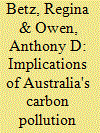

|
|
|
|
|
| Publication |
2010.
|
| Summary/Abstract |
This paper assesses the major implications for the National Electricity Market of the introduction of a domestic cap-and-trade carbon pollution reduction scheme in Australia. The electricity sector is the largest source of emissions in the Australian economy, and it is this sector, therefore, that will bear the brunt of the impact of the proposed scheme. The paper addresses core issues for the electricity market up to 2020 operating under the scheme. It focuses specifically on its impact on electricity prices and generation technology mix. These two variables have been assessed using a number of models, each applying different assumptions about key impact factors. In this paper we present a comparative summary of the results of the three highest-profile models and compare their assumptions in order to explain differences in projected outcomes. This comparison will give an indication of the likely range of impacts on the market of the current design of the scheme.
|
|
|
|
|
|
|
|
|
|
|
|
|
|
|
|
| 5 |
ID:
150049
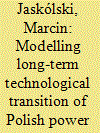

|
|
|
|
|
| Summary/Abstract |
The need for technological transition of electricity production becomes a global problem. However, in coal-dominated Polish power system this need is even more crucial than anywhere, since technical lifetime of the most domestic power plants is ending. In this paper, the impact of the EU Emission Trading Scheme (EU ETS) for CO2 combined with sulfur dioxide (SO2) and nitrogen oxides (NOx) emission trading mechanism on power technology choice was studied using Market Allocation (MARKAL) model of Polish power system. Poland can contribute to achieving ambitious EU CO2 emission reduction goals to 2050 by switching to diversified electricity mix of low-carbon coal technologies with CCS, and carbon-free options e.g. nuclear, biomass IGCC, wind onshore and offshore. This ‘low-carbon’ mix can be achieved only at high emission allowance prices, stimulated by the introduction of Market Stability Reserve to EU ETS and successive decrease in EU CO2 emission cap. At high emission allowance prices, Poland's CO2 emissions from ETS-participating electricity generating plants are expected to decrease in 2010–2050 period by 96–99%, depending on the projected electricity consumption. Model results prove that SO2/NOx emission trading scheme, envisaged in Poland, is not effective, in view of Industrial Emission Directive implementation, and should be reconsidered.
|
|
|
|
|
|
|
|
|
|
|
|
|
|
|
|
| 6 |
ID:
091550
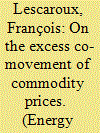

|
|
|
|
|
| Publication |
2009.
|
| Summary/Abstract |
Since the influential paper by Pindyck and Rotemberg (1990) [The excess co-movement of commodity prices. The Economic Journal 100, 1173-1189], there is a common belief that prices of unrelated commodities tend to move together in excess of what can be explained by fundamentals. In this paper, we consider monthly data of 51 commodities from 1980 to 2008 to confirm that raw resources exhibit co-movement at high frequencies. Nonetheless, focusing on oil and six metal prices, we present evidence that the high level of correlation between cycles of commodity prices can be explained to a large extent by common shocks to inventory levels. Once the influences of supply and demand are filtered out, it appears that the links between commodity prices are rather loose.
|
|
|
|
|
|
|
|
|
|
|
|
|
|
|
|
| 7 |
ID:
136190
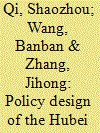

|
|
|
|
|
| Summary/Abstract |
Of seven pilot emissions trading schemes (ETS) being run in China, the ETS in Hubei province is the only provincial pilot in the central and western regions of the country with a high GDP growth rate and heavy industrial structure. As such, it is quite representative of China as a whole and its ETS will therefore be reasonably characteristic of a future nationwide market. This paper describes the policy design of the Hubei ETS, including aspects of coverage, cap, allowance allocation, transactions, compliance and penalties. Then, after making a comparison with the other Chinese pilots and emissions trading schemes in the European Union (EU) and California, the paper offers a summary of several distinct features of the Hubei ETS. First, the small numbers of entities that are covered by the scheme produce a considerable proportion of the emissions. This makes Hubei the world׳s third largest carbon market. Second, the Hubei ETS applies several mechanisms to deal with the province’s rapid growth rate. Third, the scheme׳s policy design emphasizes liquidity. In addition to these unique features, the Hubei ETS also shares some common features with all the pilots in China.
|
|
|
|
|
|
|
|
|
|
|
|
|
|
|
|
|
|
|
|
|